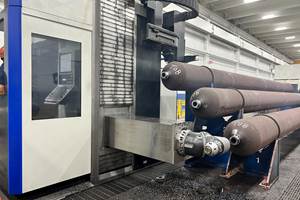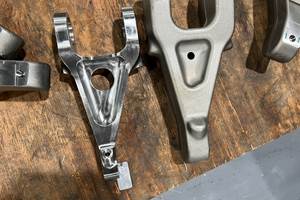Buying an HMC: What Makes Horizontal Machining Centers Different
Is it time to move up to a horizontal machining center? Let’s consider some of the structural, application and design factors that differentiate HMCs from vertical machines.
Share






This blog post is adapted from an article by Barry Rogers which appeared in the May edition of the Machine/Shop print supplement to Modern Machine Shop.
In general, shops should consider using an HMC for prismatic parts on which multiple sides or surfaces must be machined. Good examples are valve bodies or aircraft components. Typical applications for an HMC include high production volumes, parts smaller in size or jobs with longer run times. That’s not to say flat or plate stock cannot be machined on an HMC, because it can. However, this type of work must overcome some minor challenges of gravity by using appropriate fixturing. In short, horizontals can offer more flexibility than vertical machines.
The first thing that jumps out at anyone considering buying an HMC is the cost. HMCs typically have three times the purchase cost of a VMC: around $375,000, compared to $15,000 for the average VMC. Notice that I didn’t say three times the cost, but three times the purchase cost. You can easily spend $1 million if you want to purchase the most technologically advanced HMC available on the market today, including desirable options and accessories.
Why Buy a Horizontal?
The simple answer is productivity and profit. Horizontals can easily do three times the work of a comparable VMC. This assertion assumes that the workload to keep the machine busy is available. Without question, you can get more done in far less time using an HMC. With the increase in production, shop throughput is greatly improved. Because multiple operations can be done in a single setup on an HMC, less work in process must move around the shop, increasing efficiency.
An HMC can readily replace three to four verticals in many applications. This means one HMC operator can do the work of three VMC operators, thus reducing labor costs. While the monthly finance payment for an HMC may be $4,800 higher than that for a VMC, the monthly labor cost for one HMC may be $7,200 less than that for the same amount of production on VMCs. Also, because HMCs usually have more associated automation, the operator can devote less attention to it, enabling him or her to run another cell, operate other equipment or perform inspection.
Spindle Utilization
Making money on any CNC machine requires keeping the spindle running so that it is making chips with the least amount of operator intervention. A survey conducted by university researchers found that, “on average, VMC utilization, as measured by spindle run times, is 25 percent. HMC utilization is routinely 85 percent.” A shop proficient with its VMCs may have 30 to 35 percent utilization, yet this is still substantially below the utilization rate of an HMC.
In a typical eight-hour shift, the HMC cuts for about seven hours, whereas the VMC cuts for about two hours a shift. In a five-day week, the HMC gets 35 more hours a week of cutting time if it runs another shift a day, and more yet if operates six days a week.) Running only one shift, the HMC’s total overall added chip-cutting time can exceed 1,200 hours a year. The added cost of the horizontal almost becomes insignificant, provided you have the work to keep the machine fully loaded.
Flipping Parts
Whenever the operator must open the door of a VMC to load or unload the part, remove chips, perform in-process quality checks, or flip the part, the spindle must be stopped. If this part requires machining on six sides, the operator must move the part a total of seven times (load, reposition five times, unload). When the same part is being machined on an HMC, the operator touches the part only three times (load, reposition, unload). Productivity and efficiency is obviously improved. In addition, with an automatic pallet changer, the operator can handle these steps while the spindle continues cutting the part on the pallet inside the workzone. Improved quality may also result, because the HMC requires less operator intervention, which reduces the chances of loading errors or other missteps.
Machine Design Considerations
There has been a long-standing debate about whether box ways or linear guideways are better. When discussing VMCs, one could argue there isn’t enough difference to make that choice matter. It’s a different situation with HMCs. On HMCs, linear guideways have proven to be better for higher axis-travel speeds on materials such as aluminum because the acceleration and deceleration rates can be faster. As a result, cycle times can be reduced significantly. Some linear-guide HMCs reach 1G acceleration without sacrificing machine rigidity and without generating excess heat.
However, box ways can be better for certain HMC applications. Although HMCs with box ways have slower maximum programmable feed rates, performance is improved for operations in which high cutting forces are likely to be encountered. Box ways are recommended for heavy cuts in tough materials such as titanium, super alloys and tool steel. HMCs with box ways will deliver superior finishes, even in the heavier cuts in tough materials. The way the spindle head is constructed on an HMC is generally very rigid. This design resists deflection from cutting forces, thus enabling a heavier chip load and promoting longer tool life. Some HMCs with larger work envelopes have dual Y-axis ballscrews to support the proportionately greater weight of the Y and X axes.
HMCs are built for rigidity, so they tend to be much heavier than VMCs of the same size. (The average 40-by-20-inch VMC might weigh 16,000 pounds, whereas an HMC of the same size might weigh more than 40,000 pounds.) Because of the greater weight of an HMC, the foundation for this type of machine is more critical than for a VMC. The foundation must meet the HMC builder’s specification, and the machine must be properly placed and tied down. This prevents the machine from “bouncing around” during heavy cuts.
Compare machine specs from thousands of horizontal machining centers for free at techspex.com.
Find more insights about acquiring a new machining center by visiting the Techspex Knowledge Center, “Guide to Buying Machine Tools.”
Related Content
Large-Format Machining Simplifies Tube Manufacturing
Downtime is the enemy of efficient manufacturing — a problem FIBA Technologies has addressed through purchasing a Soraluce FLP 14000.
Read MoreHorizontal High-Speed Machining Saves Hundreds of Work Hours
High-speed machining is the latest change at Blair-HSM South, helping this once old-fashioned shop improve productivity and morale while enabling new work.
Read MoreDN Solutions America Unveils Impressive Chicago Technical Center at IMTS 2024
New tech center is serving as a cutting-edge showroom and a technological hub for advanced machining applications.
Read MoreFryer Offers Compact HMC for Small-Lot Machining
The Fryer HR-40 features a built-in 24" rotary table for multi-sided machining.
Read MoreRead Next
Building Out a Foundation for Student Machinists
Autodesk and Haas have teamed up to produce an introductory course for students that covers the basics of CAD, CAM and CNC while providing them with a portfolio part.
Read MoreRegistration Now Open for the Precision Machining Technology Show (PMTS) 2025
The precision machining industry’s premier event returns to Cleveland, OH, April 1-3.
Read MoreSetting Up the Building Blocks for a Digital Factory
Woodward Inc. spent over a year developing an API to connect machines to its digital factory. Caron Engineering’s MiConnect has cut most of this process while also granting the shop greater access to machine information.
Read More





























